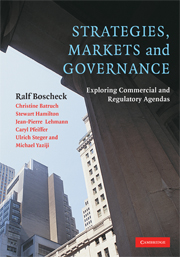Book contents
- Frontmatter
- Contents
- List of Figures, Boxes and Tables
- Acknowledgments
- Preface
- Notes on Contributors
- Part I Introduction and overview
- Part II Firm-level
- Part III Industry-level
- 9 How the clean air interstate rule will affect investment and management decisions in the US electricity sector
- 10 EU water infrastructure management: National regulations, EU framework directives but no model to follow
- 11 Market-testing healthcare: Managed care, market evolution and the search for regulatory principles
- 12 On governing natural resources
- Part IV Country/International level
- Part V An observation in closing
- Index
12 - On governing natural resources
Published online by Cambridge University Press: 06 July 2010
- Frontmatter
- Contents
- List of Figures, Boxes and Tables
- Acknowledgments
- Preface
- Notes on Contributors
- Part I Introduction and overview
- Part II Firm-level
- Part III Industry-level
- 9 How the clean air interstate rule will affect investment and management decisions in the US electricity sector
- 10 EU water infrastructure management: National regulations, EU framework directives but no model to follow
- 11 Market-testing healthcare: Managed care, market evolution and the search for regulatory principles
- 12 On governing natural resources
- Part IV Country/International level
- Part V An observation in closing
- Index
Summary
Issues and barriers to adjustment
Environmental degradation, defined by the UN as one, and possibly the main, threat facing mankind, apparently meets with little effective response.
For one, according to the Intergovernmental Panel on Climate Change, (IPCC), avoiding levels of CO2 concentration that would make current global warming trends irreversible requires the industrialized world to cut emissions to 25% of the current level by 2050, i.e. the immediate and full implementation of the Kyoto protocol by all countries including the US. In addition the fast-rising emission levels in the industrializing world need to be curbed. But the Kyoto-follow-up conference in Montreal in 2005 broke down as the US maintained its unilateral stance and developing countries rejected any “eco-colonial” restraints on their legitimate desire to catch-up. Next, melting polar ice caps, which drastically cut the level of deflected solar radiation, redirect the Gulf Stream, raise sea levels and dramatically transform flora and fauna in coastal and lower inland areas, were the main reason behind the creation of the Arctic Council in 1996. But eleven years on, the US, Canada and Russia are still unable to agree on even one countermeasure. Also, rising seas and – as a result of overstocking or over-ploughing land and deforestation – advancing deserts are shrinking the areas that are capable of supporting human habitation. Currently, China alone loses 1,400 square miles to deserts annually; in northern Africa, the Sahara pushes the populations of Morocco, Tunisia, and Algeria northward toward the Mediterranean; in the south, Nigeria, whose human and livestock population during the second half of the twentieth century grew 4-fold and 11-fold respectively, loses more than 1,300 square miles of rangeland and cropland to desertification per year.
- Type
- Chapter
- Information
- Strategies, Markets and GovernanceExploring Commercial and Regulatory Agendas, pp. 208 - 224Publisher: Cambridge University PressPrint publication year: 2008

